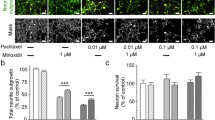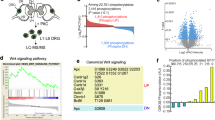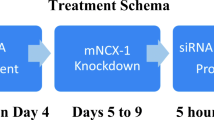Abstract
Chemotherapy-induced peripheral neuropathy (CIPN) is an irreversible off-target adverse effect of many chemotherapeutic agents such as paclitaxel, yet its mechanism is poorly understood and no preventative measure is available. CIPN is characterized by peripheral nerve damages resulting in permanent sensory function deficits. Our recent unbiased genome-wide analysis revealed that heat shock protein (Hsp) 27 is part of a transcriptional network induced by axonal injury and highly enriched for genes involved in adaptive neuronal responses, particularly axonal regeneration. To examine if Hsp27 could prevent the occurrence of CIPN, we first demonstrated that paclitaxel-induced allodynia was associated directly with axonal degeneration in sensory neurons in a mouse model of CIPN. We therefore hypothesize that by preventing axonal degeneration could prevent the development of CIPN. We drove expression of human Hsp27 (hHsp27) specifically in neurons. Development of mechanical and thermal allodynia was prevented completely in paclitaxel-treated hHsp27 transgenic mice. Strikingly, hHsp27 protected against paclitaxel-induced neurotoxicity in vivo including degeneration of afferent nerve fibers, demyelination, mitochondrial swelling, apoptosis, and restored sensory nerve action potential. Finally, we delineated signaling cascades that link CIPN development to caspase 3 and RhoA/cofilin activation in sensory neurons and peripheral nerves. hHsp27 exerted anti-apoptotic effect and maintained axon integrity by restoring caspase 3 and RhoA expression to basal levels. Taken together, our data suggest that by preventing axonal degeneration might prove beneficial as anti-CIPN drugs, which represents an emerging research area for therapeutic development.








Similar content being viewed by others
References
Au NP, Fang Y, Xi N, Lai KW, Ma CH (2014) Probing for chemotherapy-induced peripheral neuropathy in live dorsal root ganglion neurons with atomic force microscopy. Nanomedicine 10(6):1323–1333
Jaggi AS, Singh N (2011) Mechanisms in cancer-chemotherapeutic drugs-induced peripheral neuropathy. Toxicology 291(1–3):1–9
Pachman DR, Barton DL, Watson JC, Loprinzi CL (2011) Chemotherapy-induced peripheral neuropathy: prevention and treatment. Clin Pharmacol Ther 90(3):377–387
Dougherty PM, Cata JP, Cordella JV, Burton A, Weng HR (2004) Taxol-induced sensory disturbance is characterized by preferential impairment of myelinated fiber function in cancer patients. Pain 109(1–2):132–142
Windebank AJ, Grisold W (2008) Chemotherapy-induced neuropathy. J Peripher Nerv Syst 13(1):27–46
Verstappen CC, Koeppen S, Heimans JJ, Huijgens PC, Scheulen ME, Strumberg D, Kiburg B, Postma TJ (2005) Dose-related vincristine-induced peripheral neuropathy with unexpected off-therapy worsening. Neurology 64(6):1076–1077
Rowinsky EK, Chaudhry V, Cornblath DR, Donehower RC (1993) Neurotoxicity of Taxol. J Natl Cancer Inst Monogr 15:107–115
Michaud LB, Valero V, Hortobagyi G (2000) Risks and benefits of taxanes in breast and ovarian cancer. Drug Saf 23(5):401–428
Jordan MA, Wilson L (2004) Microtubules as a target for anticancer drugs. Nat Rev Cancer 4(4):253–265
Lee JJ, Swain SM (2006) Peripheral neuropathy induced by microtubule-stabilizing agents. J Clin Oncol 24(10):1633–1642
Hilkens PH, ven den Bent MJ (1997) Chemotherapy-induced peripheral neuropathy. J Peripher Nerv Syst 2(4):350–361
Siau C, Xiao W, Bennett GJ (2006) Paclitaxel- and vincristine-evoked painful peripheral neuropathies: loss of epidermal innervation and activation of Langerhans cells. Exp Neurol 201(2):507–514
Wang MS, Davis AA, Culver DG, Wang Q, Powers JC, Glass JD (2004) Calpain inhibition protects against Taxol-induced sensory neuropathy. Brain 127(Pt 3):671–679
Callizot N, Andriambeloson E, Glass J, Revel M, Ferro P, Cirillo R, Vitte PA, Dreano M (2008) Interleukin-6 protects against paclitaxel, cisplatin and vincristine-induced neuropathies without impairing chemotherapeutic activity. Cancer Chemother Pharmacol 62(6):995–1007
Smith SB, Crager SE, Mogil JS (2004) Paclitaxel-induced neuropathic hypersensitivity in mice: responses in 10 inbred mouse strains. Life Sci 74(21):2593–2604
Boyette-Davis J, Dougherty PM (2011) Protection against oxaliplatin-induced mechanical hyperalgesia and intraepidermal nerve fiber loss by minocycline. Exp Neurol 229(2):353–357
Boyette-Davis J, Xin W, Zhang H, Dougherty PM (2011) Intraepidermal nerve fiber loss corresponds to the development of taxol-induced hyperalgesia and can be prevented by treatment with minocycline. Pain 152(2):308–313
Tatsushima Y, Egashira N, Kawashiri T, Mihara Y, Yano T, Mishima K, Oishi R (2011) Involvement of substance P in peripheral neuropathy induced by paclitaxel but not oxaliplatin. J Pharmacol Exp Ther 337(1):226–235
Pan YA, Misgeld T, Lichtman JW, Sanes JR (2003) Effects of neurotoxic and neuroprotective agents on peripheral nerve regeneration assayed by time-lapse imaging in vivo. J Neurosci 23(36):11479–11488
Vuorinen VS, Roytta M (1990) Taxol-induced neuropathy after nerve crush: long-term effects on regenerating axons. Acta Neuropathol 79(6):663–671
Ma CH, Omura T, Cobos EJ, Latremoliere A, Ghasemlou N, Brenner GJ, van Veen E, Barrett L et al (2011) Accelerating axonal growth promotes motor recovery after peripheral nerve injury in mice. J Clin Invest 121(11):4332–4347
Lavoie JN, Gingras-Breton G, Tanguay RM, Landry J (1993) Induction of Chinese hamster HSP27 gene expression in mouse cells confers resistance to heat shock. HSP27 stabilization of the microfilament organization. J Biol Chem 268(5):3420–3429
Stetler RA, Cao G, Gao Y, Zhang F, Wang S, Weng Z, Vosler P, Zhang L et al (2008) Hsp27 protects against ischemic brain injury via attenuation of a novel stress-response cascade upstream of mitochondrial cell death signaling. J Neurosci 28(49):13038–13055
Huot J, Houle F, Spitz DR, Landry J (1996) HSP27 phosphorylation-mediated resistance against actin fragmentation and cell death induced by oxidative stress. Cancer Res 56(2):273–279
Lavoie JN, Lambert H, Hickey E, Weber LA, Landry J (1995) Modulation of cellular thermoresistance and actin filament stability accompanies phosphorylation-induced changes in the oligomeric structure of heat shock protein 27. Mol Cell Biol 15(1):505–516
Pichon S, Bryckaert M, Berrou E (2004) Control of actin dynamics by p38 MAP kinase - Hsp27 distribution in the lamellipodium of smooth muscle cells. J Cell Sci 117(Pt 12):2569–2577
Benndorf R, Hayess K, Ryazantsev S, Wieske M, Behlke J, Lutsch G (1994) Phosphorylation and supramolecular organization of murine small heat shock protein HSP25 abolish its actin polymerization-inhibiting activity. J Biol Chem 269(32):20780–20784
Chaudhuri S, Smith PG (2008) Cyclic strain-induced HSP27 phosphorylation modulates actin filaments in airway smooth muscle cells. Am J Respir Cell Mol Biol 39(3):270–278
Tezel G, Wax MB (2000) The mechanisms of hsp27 antibody-mediated apoptosis in retinal neuronal cells. J Neurosci 20(10):3552–3562
Caroni P (1997) Overexpression of growth-associated proteins in the neurons of adult transgenic mice. J Neurosci Methods 71(1):3–9
Torres L, Danver J, Ji K, Miyauchi JT, Chen D, Anderson ME, West BL, Robinson JK et al (2016) Dynamic microglial modulation of spatial learning and social behavior. Brain Behav Immun 55:6–16
Flatters SJ, Bennett GJ (2004) Ethosuximide reverses paclitaxel- and vincristine-induced painful peripheral neuropathy. Pain 109(1–2):150–161
Polomano RC, Mannes AJ, Clark US, Bennett GJ (2001) A painful peripheral neuropathy in the rat produced by the chemotherapeutic drug, paclitaxel. Pain 94(3):293–304
Griffin RS, Costigan M, Brenner GJ, Ma CH, Scholz J, Moss A, Allchorne AJ, Stahl GL et al (2007) Complement induction in spinal cord microglia results in anaphylatoxin C5a-mediated pain hypersensitivity. J Neurosci 27(32):8699–8708
Korngut L, Ma CH, Martinez JA, Toth CC, Guo GF, Singh V, Woolf CJ, Zochodne DW (2012) Overexpression of human HSP27 protects sensory neurons from diabetes. Neurobiol Dis 47(3):436–443
Dixon WJ (1965) The up-and-down method for small samples. J Am Stat Assoc 60(312):967–978
Ward SJ, Ramirez MD, Neelakantan H, Walker EA (2011) Cannabidiol prevents the development of cold and mechanical allodynia in paclitaxel-treated female C57Bl6 mice. Anesth Analg 113(4):947–950
Choi Y, Yoon YW, Na HS, Kim SH, Chung JM (1994) Behavioral signs of ongoing pain and cold allodynia in a rat model of neuropathic pain. Pain 59(3):369–376
Materazzi S, Fusi C, Benemei S, Pedretti P, Patacchini R, Nilius B, Prenen J, Creminon C et al (2012) TRPA1 and TRPV4 mediate paclitaxel-induced peripheral neuropathy in mice via a glutathione-sensitive mechanism. Pflugers Arch 463(4):561–569
Decosterd I, Woolf CJ (2000) Spared nerve injury: an animal model of persistent peripheral neuropathic pain. Pain 87(2):149–158
Asthana P, Zhang N, Kumar G, Chine VB, Singh KK, Mak YL, Chan LL, Lam PKS et al (2018) Pacific ciguatoxin induces excitotoxicity and neurodegeneration in the motor cortex via caspase 3 activation: implication for irreversible motor deficit. Mol Neurobiol 55(8):6769–6787
Painter MW, Brosius Lutz A, Cheng YC, Latremoliere A, Duong K, Miller CM, Posada S, Cobos EJ et al (2014) Diminished Schwann cell repair responses underlie age-associated impaired axonal regeneration. Neuron 83(2):331–343
Bobylev I, Joshi AR, Barham M, Ritter C, Neiss WF, Höke A, Lehmann HC (2015) Paclitaxel inhibits mRNA transport in axons. Neurobiol Dis 82:321–331
Wozniak KM, Wu Y, Farah MH, Littlefield BA, Nomoto K, Slusher BS (2013) Neuropathy-inducing effects of eribulin mesylate versus paclitaxel in mice with preexisting neuropathy. Neurotox Res 24(3):338–344
Ma KH, Hung HA, Srinivasan R, Xie H, Orkin SH, Svaren J (2015) Regulation of peripheral nerve myelin maintenance by gene repression through polycomb repressive complex 2. J Neurosci 35(22):8640–8652
Boehmerle W, Huehnchen P, Peruzzaro S, Balkaya M, Endres M (2014) Electrophysiological, behavioral and histological characterization of paclitaxel, cisplatin, vincristine and bortezomib-induced neuropathy in C57Bl/6 mice. Sci Rep 4:6370
Cliffer KD, Siuciak JA, Carson SR, Radley HE, Park JS, Lewis DR, Zlotchenko E, Nguyen T et al (1998) Physiological characterization of Taxol-induced large-fiber sensory neuropathy in the rat. Ann Neurol 43(1):46–55
Huehnchen P, Boehmerle W, Endres M (2013) Assessment of paclitaxel induced sensory polyneuropathy with “Catwalk” automated gait analysis in mice. PLoS One 8(10):e76772
Quasthoff S, Hartung HP (2002) Chemotherapy-induced peripheral neuropathy. J Neurol 249(1):9–17
Sahenk Z, Barohn R, New P, Mendell JR (1994) Taxol neuropathy: electrodiagnostic and sural nerve biopsy findings. Arch Neurol 51(7):726–729
van den Bent MJ, van Raaij-van den Aarssen VJ, Verweij J, Doorn PA, Sillevis Smitt PA (1997) Progression of paclitaxel-induced neuropathy following discontinuation of treatment. Muscle Nerve 20(6):750–752
Flatters SJ, Bennett GJ (2006) Studies of peripheral sensory nerves in paclitaxel-induced painful peripheral neuropathy: evidence for mitochondrial dysfunction. Pain 122(3):245–257
Arrieta O, Hernandez-Pedro N, Fernández-González-Aragón M, Saavedra-Perez D, Campos-Parra A, Rios-Trejo M, Cerón-Lizárraga T, Martínez-Barrera L et al (2011) Retinoic acid reduces chemotherapy-induced neuropathy in an animal model and patients with lung cancer. Neurology 77(10):987–995
Lipton RB, Apfel SC, Dutcher JP, Rosenberg R, Kaplan J, Berger A, Einzig AI, Wiernik P et al (1989) Taxol produces a predominantly sensory neuropathy. Neurology 39(3):368–373
Chen X, Stubblefield MD, Custodio CM, Hudis CA, Seidman AD, DeAngelis LM (2013) Electrophysiological features of taxane-induced polyneuropathy in patients with breast cancer. J Clin Neurophysiol 30(2):199–203
Park SB, Lin CSY, Krishnan AV, Friedlander ML, Lewis CR, Kiernan MC (2011) Early, progressive, and sustained dysfunction of sensory axons underlies paclitaxel-induced neuropathy. Muscle Nerve 43(3):367–374
Weil MT, Mobius W, Winkler A, Ruhwedel T, Wrzos C, Romanelli E, Bennett JL, Enz L et al (2016) Loss of myelin basic protein function triggers myelin breakdown in models of demyelinating diseases. Cell Rep 16(2):314–322
Purves D, Augustine G, Fitzpatrick D, Katz L, LaMantia A, McNamara J, Williams S (2004) Increased conduction velocity as a result of myelination. Neuroscience. In: Neuroscience, 3nd edn. Sinauer Associates, Sunderland, pp 63–65
Flatters SJ, Xiao W-H, Bennett GJ (2006) Acetyl-L-carnitine prevents and reduces paclitaxel-induced painful peripheral neuropathy. Neurosci Lett 397(3):219–223
Xiao WH, Bennett GJ (2012) Effects of mitochondrial poisons on the neuropathic pain produced by the chemotherapeutic agents, paclitaxel and oxaliplatin. Pain 153(3):704–709
Griffiths LA, Flatters SJ (2015) Pharmacological modulation of the mitochondrial electron transport chain in paclitaxel-induced painful peripheral neuropathy. J Pain 16(10):981–994
Krukowski K, Nijboer CH, Huo X, Kavelaars A, Heijnen CJ (2015) Prevention of chemotherapy-induced peripheral neuropathy by the small-molecule inhibitor pifithrin-μ. Pain 156(11):2184–2192
Joseph EK, Levine JD (2006) Mitochondrial electron transport in models of neuropathic and inflammatory pain. Pain 121(1):105–114
Zheng H, Xiao WH, Bennett GJ (2012) Mitotoxicity and bortezomib-induced chronic painful peripheral neuropathy. Exp Neurol 238(2):225–234
Neumar RW, Xu YA, Gada H, Guttmann RP, Siman R (2003) Cross-talk between calpain and caspase proteolytic systems during neuronal apoptosis. J Biol Chem 278(16):14162–14167
Huang ZZ, Li D, Liu CC, Cui Y, Zhu HQ, Zhang WW, Li YY, Xin WJ (2014) CX3CL1-mediated macrophage activation contributed to paclitaxel-induced DRG neuronal apoptosis and painful peripheral neuropathy. Brain Behav Immun 40:155–165
Friesland A, Weng Z, Duenas M, Massa SM, Longo FM, Lu Q (2014) Amelioration of cisplatin-induced experimental peripheral neuropathy by a small molecule targeting p75 NTR. Neurotoxicology 45:81–90
James SE, Burden H, Burgess R, Xie Y, Yang T, Massa SM, Longo FM, Lu Q (2008) Anti-cancer drug induced neurotoxicity and identification of Rho pathway signaling modulators as potential neuroprotectants. Neurotoxicology 29(4):605–612
James SE, Dunham M, Carrion-Jones M, Murashov A, Lu Q (2010) Rho kinase inhibitor Y-27632 facilitates recovery from experimental peripheral neuropathy induced by anti-cancer drug cisplatin. Neurotoxicology 31(2):188–194
Qiu Y, Chen WY, Wang ZY, Liu F, Wei M, Ma C, Huang YG (2016) Simvastatin attenuates neuropathic pain by inhibiting the RhoA/LIMK/cofilin pathway. Neurochem Res 41(9):2457–2469
Scuteri A, Nicolini G, Miloso M, Bossi M, Cavaletti G, Windebank AJ, Tredici G (2006) Paclitaxel toxicity in post-mitotic dorsal root ganglion (DRG) cells. Anticancer Res 26(2A):1065–1070
Melli G, Taiana M, Camozzi F, Triolo D, Podini P, Quattrini A, Taroni F, Lauria G (2008) Alpha-lipoic acid prevents mitochondrial damage and neurotoxicity in experimental chemotherapy neuropathy. Exp Neurol 214(2):276–284
Liu XJ, Zhang Y, Liu T, Xu ZZ, Park CK, Berta T, Jiang D, Ji RR (2014) Nociceptive neurons regulate innate and adaptive immunity and neuropathic pain through MyD88 adapter. Cell Res 24(11):1374–1377
Berta T, Park CK, Xu ZZ, Xie RG, Liu T, Lu N, Liu YC, Ji RR (2014) Extracellular caspase-6 drives murine inflammatory pain via microglial TNF-alpha secretion. J Clin Invest 124(3):1173–1186
Berta T, Qadri YJ, Chen G, Ji RR (2016) Microglial signaling in chronic pain with a special focus on caspase 6, p38 MAP kinase, and sex dependence. J Dent Res 95(10):1124–1131
Benn SC, Perrelet D, Kato AC, Scholz J, Decosterd I, Mannion RJ, Bakowska JC, Woolf CJ (2002) Hsp27 upregulation and phosphorylation is required for injured sensory and motor neuron survival. Neuron 36(1):45–56
André N, Braguer D, Brasseur G, Gonçalves A, Lemesle-Meunier D, Guise S, Jordan MA, Briand C (2000) Paclitaxel induces release of cytochrome c from mitochondria isolated from human neuroblastoma cells. Cancer Res 60(19):5349–5353
Mehlen P, Kretz-Remy C, Preville X, Arrigo A-P (1996) Human hsp27, Drosophila hsp27 and human alphaB-crystallin expression-mediated increase in glutathione is essential for the protective activity of these proteins against TNFalpha-induced cell death. EMBO J 15(11):2695–2706
Wang C, Song S, Zhang Y, Ge Y, Fang X, Huang T, Du J, Gao J (2015) Inhibition of the Rho/Rho kinase pathway prevents lipopolysaccharide-induced hyperalgesia and the release of TNF-alpha and IL-1beta in the mouse spinal cord. Sci Rep 5:14553
Zulauf L, Coste O, Marian C, Moser C, Brenneis C, Niederberger E (2009) Cofilin phosphorylation is involved in nitric oxide/cGMP-mediated nociception. Biochem Biophys Res Commun 390(4):1408–1413
Wu KY, Hengst U, Cox LJ, Macosko EZ, Jeromin A, Urquhart ER, Jaffrey SR (2005) Local translation of RhoA regulates growth cone collapse. Nature 436(7053):1020–1024
Qin Q, Baudry M, Liao G, Noniyev A, Galeano J, Bi X (2009) A novel function for p53: regulation of growth cone motility through interaction with Rho kinase. J Neurosci 29(16):5183–5192
Tanaka H, Yamashita T, Asada M, Mizutani S, Yoshikawa H, Tohyama M (2002) Cytoplasmic p21(Cip1/WAF1) regulates neurite remodeling by inhibiting Rho-kinase activity. J Cell Biol 158(2):321–329
Sun X, Zhou Z, Fink DJ, Mata M (2013) HspB1 silences translation of PDZ-RhoGEF by enhancing miR-20a and miR-128 expression to promote neurite extension. Mol Cell Neurosci 57:111–119
Chandran V, Coppola G, Nawabi H, Omura T, Versano R, Huebner EA, Zhang A, Costigan M et al (2016) A systems-level analysis of the peripheral nerve intrinsic axonal growth program. Neuron 89(5):956–970
Acknowledgements
This work is supported in part by GRF grants from The Research Grant Council of the Hong Kong Special Administrative Region Government (CityU 11100015 and CityU 11100417), and the Health and Medical Research Fund, Food and Health Bureau, Hong Kong Special Administrative Region Government (05160126) award to Chi Ma.
Author information
Authors and Affiliations
Contributions
VC carried out the neurobehavioral assessment, in vivo electrophysiological recording, immunohistochemistry of skin and nerve biopsies, electron microscopy, TUNEL assay, and Western blot analysis for cleaved caspase 3 protein expression. NPBA performed in vitro DRG culture analysis and Western blot analysis for RhoA/cofilin activation. GK validated and standardized SNAP and NCV recording. CHEM conceived the project, designed the study, and wrote the manuscript with inputs from all authors. All authors read and approved the final manuscript.
Corresponding author
Ethics declarations
Conflict of Interest
The authors declare that they have no conflict of interest.
Electronic Supplementary Material
ESM 1
(PDF 9231 kb)
Rights and permissions
About this article
Cite this article
Chine, V.B., Au, N.P.B., Kumar, G. et al. Targeting Axon Integrity to Prevent Chemotherapy-Induced Peripheral Neuropathy. Mol Neurobiol 56, 3244–3259 (2019). https://doi.org/10.1007/s12035-018-1301-8
Received:
Accepted:
Published:
Issue Date:
DOI: https://doi.org/10.1007/s12035-018-1301-8




